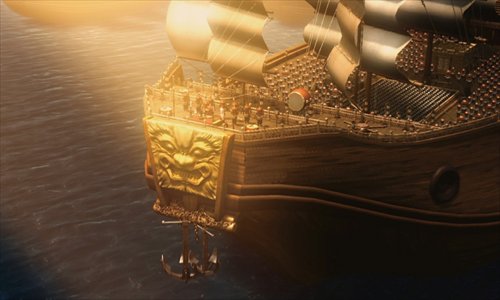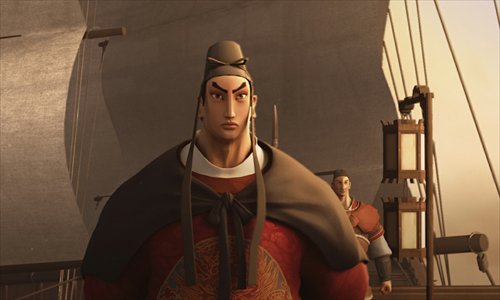An animated struggle


Voyage Extraordinaire presents the story of Zheng He with lavish scenes rarely undertaken by other Chinese animated films. Photos: Courtesy of Nanjing Zhuque Animation
So-called "one-day cinema tours" usually describe low budget films with no stars that appear in theaters for a single day. However, this month, a big-budget 3D animated film called Voyage Extraordinaire also made a hasty exit from theaters.
Last Friday, the film premiered nationally but only for a few daytime slots. A concurrent 3D animation, the US import Epic, is still performing well in cinemas. This failure to launch has film industry watchers wondering, do domestic animated films have any sway with moviegoers all?
Big fish in a little pond
In Voyage Extraordinaire, two students accidentally time travel to the Ming Dynasty (1368-1644) and witness Zheng He's legendary voyages.
A national hero, Zheng (1371-1433) was an admiral known for successfully sailing westward seven times for trade and exploration.
Having both courage and maritime smarts, Zheng was commissioned by Emperor Yongle and Emperor Xuande to travel to the South China Sea and Indian Ocean.
His trips later also reached the Arabian Peninsula and East Africa. The expeditions allowed many foreign countries to learn of the Ming Dynasty's military power and political influence.
The fleets under Zheng's command were said to have represented the latest Chinese technology of the time.
Produced by Nanjing Zhuque Animation, the 90-minute film took 30 million yuan ($4.9 million) and three years to complete, a rarity in the largely low-budget Chinese animation industry.
According to producer Zhu Yichang, the project also received the support of many big names. Writer Su Tong, who wrote the book that the 1991 film Raise the Red Lantern is based on, advised on the script. Pop singers Zhang Liangying and Liu Huan sang on the film's soundtrack.
Zhu said all the details of the film were based on historical records. From this source material, the filmmakers created a story filled with adventure and romance. But now, all these efforts are no longer available for audiences to see.
What went wrong?
"No cinemas or good time slots for us," Zhu said. While he is exaggerating, Zhu couldn't mask his disappointment. "I just don't know why they couldn't give us a chance. The cinemas in China rely too much on the market reaction, which is a misleading measure."
Some viewers took to the Web to voice their dissatisfaction with the film. A Nanjing-based Sina Weibo user with the name Zai renjian de zhu posted that "the production is quite excellent, [but] it's for kids, especially primary-school boys."
Movie critic Lie Wen posted on his Weibo account that the 3D technology isn't used well, and "only some scenes are acceptable." He added that some plot lines seemed to be pulled from Pirates of the Caribbean.
But Liu Jiarui, who has many years of experience in the animation industry, found that Voyage Extraordinaire makes exciting breakthroughs in several different parts of the production. Unlike many domestic animations that focus on a single character or a small group, this film dares to take on big scenes with large numbers of characters involved.
"I am a tech person so I know the representation of water is a very difficult part of the process," Liu said. "It was a large investment of time and finance but due to many reasons the result is not satisfying. ... Many things are beyond the control of a production team."
Different from Zhu's critical view on the failed distribution, Liu sees the main problem as one from inside the industry itself.
"The industry is immature," he said. "We are still looking for the best means of distribution, marketing, development of spin-offs and so on."
Promising future
Yang Buting, director of the China Film Distribution and Screening Association, said in an interview with China Economic Net that for 2012's 17.17 billion yuan Chinese box office, animated films accounted for less than 8 percent, or about 1.35 billion yuan. And among all the animated films, only 20 were domestic. Those earned just 400 million yuan.
Though the statistics aren't promising, Yang also mentioned that the situation has improved in 2013, reaching the same box-office sales of previous years in the first half of the year.
There are also other positive indicators. Not long ago, a seven-minute animation named Entrance Exam grabbed a lot of attention online. Audiences called Entrance Exam a "Chinese Pixar-style" work. It was later reported that the young couple behind the short film spent 15 months at home to finish the project.
"Entrance Exam is more like a sketch and the case for long projects will be different," remarked Zhu, who also emphasized that online distribution would not likely become a mainstream channel for animated films. The future will still rely on cinema screenings, he said.